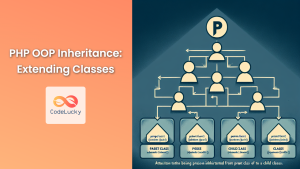In the world of Object-Oriented Programming (OOP) in PHP, constructors play a crucial role in initializing objects. They are special methods that are automatically called when an object is created, allowing you to set initial values and perform any setup operations. Let's dive deep into PHP constructors and explore their power and flexibility.
What is a Constructor?
A constructor is a special method within a class that is automatically called when an object of that class is instantiated. In PHP, the constructor method is always named __construct().
🔑 Key points about constructors:
- They initialize object properties
- They can accept parameters
- They don't have a return type
Let's start with a basic example:
class Car {
public $brand;
public $model;
public function __construct($brand, $model) {
$this->brand = $brand;
$this->model = $model;
}
}
$myCar = new Car("Toyota", "Corolla");
echo "My car is a {$myCar->brand} {$myCar->model}";
Output:
My car is a Toyota Corolla
In this example, the Car class has a constructor that takes two parameters: $brand and $model. When we create a new Car object, these values are immediately assigned to the object's properties.
Constructor Overloading
PHP doesn't support method overloading in the traditional sense, but we can achieve similar functionality using default parameter values:
class Book {
public $title;
public $author;
public $year;
public function __construct($title = "", $author = "", $year = null) {
$this->title = $title;
$this->author = $author;
$this->year = $year;
}
public function getInfo() {
return "'{$this->title}' by {$this->author}" . ($this->year ? " ({$this->year})" : "");
}
}
$book1 = new Book("1984", "George Orwell", 1949);
$book2 = new Book("To Kill a Mockingbird", "Harper Lee");
$book3 = new Book("The Great Gatsby");
echo $book1->getInfo() . "\n";
echo $book2->getInfo() . "\n";
echo $book3->getInfo() . "\n";
Output:
'1984' by George Orwell (1949)
'To Kill a Mockingbird' by Harper Lee
'The Great Gatsby' by
This approach allows us to create Book objects with varying amounts of information, providing flexibility in object initialization.
Property Promotion in Constructors
PHP 8.0 introduced a new feature called constructor property promotion, which allows you to define and initialize properties in one go:
class Person {
public function __construct(
public string $name,
public int $age,
private string $ssn
) {}
public function getInfo() {
return "{$this->name} is {$this->age} years old.";
}
}
$person = new Person("John Doe", 30, "123-45-6789");
echo $person->getInfo();
Output:
John Doe is 30 years old.
This syntax reduces boilerplate code and makes the class definition more concise.
Calling Parent Constructors
When working with inheritance, it's often necessary to call the parent class's constructor. This is done using the parent::__construct() method:
class Vehicle {
protected $type;
public function __construct($type) {
$this->type = $type;
}
}
class ElectricVehicle extends Vehicle {
private $batteryCapacity;
public function __construct($type, $batteryCapacity) {
parent::__construct($type);
$this->batteryCapacity = $batteryCapacity;
}
public function getInfo() {
return "This {$this->type} has a battery capacity of {$this->batteryCapacity} kWh.";
}
}
$tesla = new ElectricVehicle("sedan", 75);
echo $tesla->getInfo();
Output:
This sedan has a battery capacity of 75 kWh.
By calling parent::__construct($type), we ensure that the $type property is properly initialized in the parent Vehicle class.
Late Static Binding in Constructors
PHP's late static binding allows for more flexible use of the static keyword. This can be particularly useful in constructors when dealing with inheritance:
class Animal {
protected static $count = 0;
public function __construct() {
static::$count++;
}
public static function getCount() {
return static::$count;
}
}
class Dog extends Animal {
protected static $count = 0;
}
class Cat extends Animal {
protected static $count = 0;
}
$dog1 = new Dog();
$dog2 = new Dog();
$cat1 = new Cat();
echo "Number of Dogs: " . Dog::getCount() . "\n";
echo "Number of Cats: " . Cat::getCount() . "\n";
echo "Number of Animals: " . Animal::getCount() . "\n";
Output:
Number of Dogs: 2
Number of Cats: 1
Number of Animals: 0
In this example, the static keyword in the parent constructor refers to the class in which it's being called, allowing for separate counts for each animal type.
Dependency Injection in Constructors
Constructors are an excellent place to implement dependency injection, a design pattern that helps create loosely coupled code:
interface DatabaseInterface {
public function connect();
}
class MySQLDatabase implements DatabaseInterface {
public function connect() {
return "Connected to MySQL";
}
}
class PostgreSQLDatabase implements DatabaseInterface {
public function connect() {
return "Connected to PostgreSQL";
}
}
class UserRepository {
private $database;
public function __construct(DatabaseInterface $database) {
$this->database = $database;
}
public function getUsers() {
$connection = $this->database->connect();
return $connection . " and fetching users";
}
}
$mysqlRepo = new UserRepository(new MySQLDatabase());
$postgresRepo = new UserRepository(new PostgreSQLDatabase());
echo $mysqlRepo->getUsers() . "\n";
echo $postgresRepo->getUsers();
Output:
Connected to MySQL and fetching users
Connected to PostgreSQL and fetching users
By injecting the database dependency through the constructor, we've made our UserRepository class more flexible and easier to test.
Private Constructors and the Singleton Pattern
Sometimes, you might want to restrict the instantiation of a class to a single object. This is where the Singleton pattern comes in handy, and it relies on a private constructor:
class Singleton {
private static $instance = null;
private $data;
private function __construct() {
$this->data = "I am a singleton!";
}
public static function getInstance() {
if (self::$instance === null) {
self::$instance = new self();
}
return self::$instance;
}
public function getData() {
return $this->data;
}
}
$singleton1 = Singleton::getInstance();
$singleton2 = Singleton::getInstance();
echo $singleton1->getData() . "\n";
echo "Are \$singleton1 and \$singleton2 the same instance? " .
(($singleton1 === $singleton2) ? "Yes" : "No");
Output:
I am a singleton!
Are $singleton1 and $singleton2 the same instance? Yes
The private constructor ensures that the class cannot be instantiated from outside, while the getInstance() method controls object creation, ensuring only one instance exists.
Constructors in Abstract Classes
Abstract classes can have constructors, which are then called when a concrete class extending the abstract class is instantiated:
abstract class Shape {
protected $color;
public function __construct($color) {
$this->color = $color;
}
abstract public function getArea();
public function getColor() {
return $this->color;
}
}
class Circle extends Shape {
private $radius;
public function __construct($color, $radius) {
parent::__construct($color);
$this->radius = $radius;
}
public function getArea() {
return pi() * $this->radius ** 2;
}
}
$circle = new Circle("Red", 5);
echo "The {$circle->getColor()} circle has an area of " . round($circle->getArea(), 2);
Output:
The Red circle has an area of 78.54
Here, the Shape constructor is called first to set the color, followed by the Circle constructor to set the radius.
Error Handling in Constructors
Constructors can throw exceptions to handle errors during object initialization:
class BankAccount {
private $balance;
public function __construct($initialBalance) {
if ($initialBalance < 0) {
throw new InvalidArgumentException("Initial balance cannot be negative");
}
$this->balance = $initialBalance;
}
public function getBalance() {
return $this->balance;
}
}
try {
$account1 = new BankAccount(100);
echo "Account 1 balance: $" . $account1->getBalance() . "\n";
$account2 = new BankAccount(-50);
} catch (InvalidArgumentException $e) {
echo "Error: " . $e->getMessage();
}
Output:
Account 1 balance: $100
Error: Initial balance cannot be negative
This approach ensures that objects are always in a valid state after creation.
Conclusion
Constructors are a powerful feature in PHP's object-oriented programming model. They provide a clean way to initialize objects, implement dependency injection, and ensure proper object setup. By mastering constructors, you can create more robust and flexible PHP applications.
Remember these key points about PHP constructors:
- They are called automatically when an object is created
- They can accept parameters for flexible object initialization
- They can call parent constructors in inheritance scenarios
- They can be used to implement design patterns like Dependency Injection and Singleton
- They can include error handling to ensure valid object states
By leveraging these concepts, you'll be well on your way to writing cleaner, more maintainable PHP code. Happy coding! 🚀



















